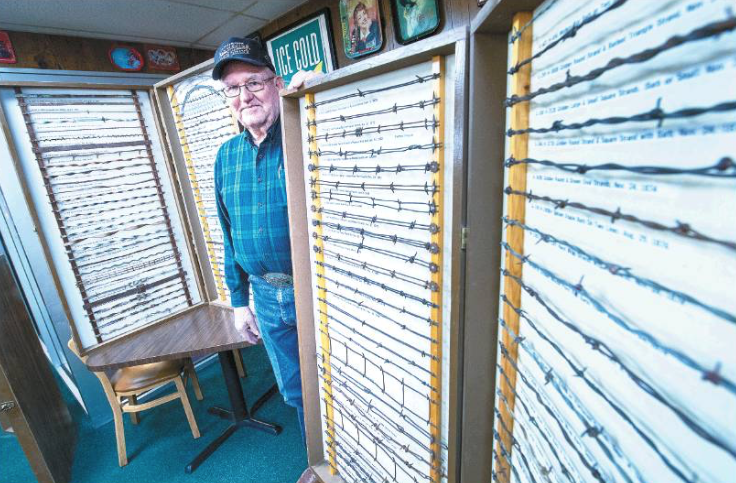
Barbed wire changed the face of the west. And it absolutely fascinates Hobbs collector Bobby Cox, so much so his friends call him “Barbed Wire Bobby.”
Cox’s interest in the spiky fencing material started when he bought his property on West Bender Boulevard in February 1973, he said. There, he found a stretch of wire fencing bordering the land he’d bought from long-time Hobbs judge, Robert L. Bensing.
“There was a piece of wire that had steel barbs on it,” Cox recalled. “I took it down and took it out to the state line — there was a barber shop out there called Curly’s Barber Shop and he had some barbed wire on the wall out there.”
Asking if it was worth anything, the proprietor told him it was worth about $5 per 18-inch section.
“He said, ‘I don’t have that (in my collection),’” Cox said. “I asked him if he wanted it and he said, ‘no, but I’ll sell you mine.’ So I bought his collection for $150.”

That’s how he acquired his first 17 pieces of barbed wire, Cox said. But that was just the beginning.
Today, he has more than 600,
18-inch pieces in his collection, all mounted i n display boxes and labeled by type, what company made them and the year they were in use. Cox’s collection even includes a piece of German concertina wire — military grade but barbed wire, nonetheless — he acquired after the fall of the Berlin Wall in 1989.
Each piece in his collection is unique — some may look the same, but the materials used to make them, the shape of the barbs, how their attached, all are different. The railroad companies of the 19th century even had their own design — known to collectors as railroad wire — used to line the rights of way and keep livestock off the tracks, Cox said.
Cox said, through research, he knows of about 1,400 different types of barbed wire that were used in the United States. Collector resources online indicate that number could be as many as 2,000, with more than 800 separate patents applied for over the years.
“It’s the history,” Cox said of his love of barbed wire. “I’ve got many different kinds and they’re every one different.”
And he’s not alone. Thousands of people around the world collect barbed wire. There are museum dedicated to the stuff and annual conventions where aficionados gather to buy, sell and trade barbed wire. Cox has attended several, he said.
One of his first conventions was in the mid-1970. Cox was traveling with his wife to Vernal, Utah, for a job, scheduled to be there for week. Driving through Santa Fe, though, his travel plans got briefly derailed to feed his habit.
“Across St. Francis Street was a banner announcing the second annual New Mexico Barbed Wire Collectors Convention,” he remembered. “We got a room, spent the night and ended up going and looking around the convention.”
After moving around the state for several years, the New Mexico convention finally shut down. But Cox has attended similar conventions in Texas, at Amarillo, Lubbock and Fort Stockton. But conventions aren’t his only source.
Years ago, he recalled, Cox was driving around and he saw a type of barbed wire he didn’t have in his collection. Problem was, it was part of an existing fence. Not deterred, and knowing he had a roll of fresh barbed wire and the necessary tools in his truck, he clipped a length from the fence and spliced in a new piece.
“Then, here comes the foreman,” Cox said. “He asked, ‘Bobby, what are you doing?’ I told him the fence was broke, so I fixed it.
“That afternoon, it got to bothering me, so I went to his house and told him I didn’t have that type in my collection and I wanted some,” Cox said. “He said, ‘I don’t mind as long as you fixed the fence.’”
Lucien Smith produced the first known prototype, under the name “Thorny Wire,” in the early 1860s. It was mostly made by hand, so was expensive and out of the reach of many, Cox said.
That was until 1874, when the man called the father of barbed wire, Joseph Glidden, won a lawsuit guaranteeing his right to patent a machine to twist two strands of wire and insert the pointed barbs. That resulted in one of the most prevalent barbed wire designs, called Winner, due to Glidden having won the lawsuit, Cox said.
That first year, Glidden’s De Kalb, Ill., manufacturing plant produced 32 miles of barbed wire, according to a 2017 BBC report on the subject. Just six years later, in 1880, that same plant produced more than 263,000 miles — enough barbed wire to circle the earth 10 times.
When barbed wire first became an inexpensive way to secure property, breaking the “open range” concept that prevailed in the west in the 19th century, it was almost universally hated by ranchers who saw their way of life changing, Cox said. But it definitely changed things across the western states.
“People had their horses and cattle and goats and sheep and all, but they couldn’t contain them,” he said. “People would have gardens of fields and the cattle would go and eat the crops.
“The west wouldn’t have become what it is without barbed wire,” Cox said. “There wouldn’t be any way to take care of the animals.










